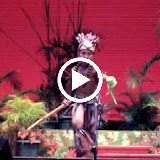

This may not be your cup of tea, but I would be curious about the cost to travel for a family of four (2 adults and 2 young ladies) for 3 months internationally. Since we only visited the Cook Islands and New Zealand the accounting is pretty straight forward as all the currency was in the New Zealand Dollar. The average exchange rate for the 3 months we travelled hovered right around .52. Essentially every US dollar would get you about $1.92 NZ. Not bad... and by the end of the trip the exchange rate was almost $1 US = $2 NZ. The exchange rate was definitely in our favor. I've converted the cost of the trip from NZ dollars to US dollars. The details are as follows in US dollars:
Transportation Cost Include (Airfare, Inter-Island Ferry, Scooters, Car Rental, Car Insurance, Van Rental, Van Insurance, Car License 'Cook Islands', New Tire, Gas, Other Ferry, Car Wash, Cook Island Extortion Fee, Parking)
$10,346
Lodging (Includes all lodging + camping. Many nights were free or in the $0-$20 range while camping in Department of Conservation campgrounds, or up in the woods... We tent camped about 35 nights drastically reducing our lodging costs. Much of our camping gear was compact and fit into two large suitcases. We slept on boats, houseboats, farms, cottages, beach huts, hostels, backpacker lodges, motor camps, holiday parks, homes and planes.)
$3,099 total or $38.26 a night
Groceries and Eating Out (We purchased most of our food at the grocery stores and markets and made our own meals. We dined out less than 10 times. We visited McDonald's 4 times and KFC 1 time. We had 2 nice meals out...one time for Curt's B-day and One time with Fred and Kristine our friends and hosts in Aitutaki. We did visit a few bakeries for the odd pastry and cappuccino, and did have the random lunch here and there. On a few occasions the excursions we were taking part in provided a nice lunch or dinner (this cost is also included in this category.) All in all we fixed and ate most of our own meals. Our cooler that was full of camping gear on the way down to NZ provided a nice place to keep perishables while travelling. Also, groceries include ice cream stops, smoothies, candy, wine, beer or other food item consumed.)
$1,814 Groceries + $534 Eating Out = $2,348 total or $29 daily
Action Adventure and Excursions (Includes kayak trips, fishing, overnight cruise, bungy jumping, flying fox, zorbing, para flights, cave tours, snorkel tours, thermal mud baths, fire shows, dance shows, volcanic valley hike, museums, jet boat rides, chocolate factory tour, Milford Sound tour, Doubtful Sound tour, spa swimming, stilt walking, hobbiton, water park, concert, sand dune sledding, gold mining)
$2,707
Laundry (Any Laundry we paid to clean. We did laundry for free at any place that would offer.)
$16
Internet Usage (Including all Internet cafes, Internet libraries, Internet at homes, Internet at motor lodges or any other facility we had to pay for Internet usage. Sometimes usage was free.)
$83
Miscellaneous (Includes all gifts, books, pharmacy, church, propane, all mail, making a key, any tips for guides.)
$455
For a Grand Total of $19,054 US
As you can see the bulk of the trips cost was made up from transportation. Airfare alone cost us over $8,000, but it did include a stop in Rarotonga and Aitutaki in the Cook Islands. If you are interested about any of the above costs broken down even further I can bore you with any of the data. For instance, our van cost $1,540 NZ for 56 days. About $800 US... and that included additional insurance protection. Please let me know about further costs if you are curious... Curt

















